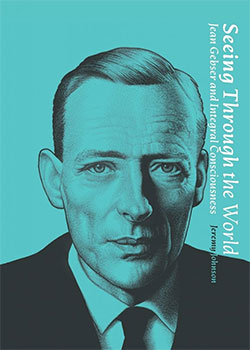Cynthia Bourgeault continues her series of reflections upon Integral structures of consciousness and ideas brought forth in Jean Gebser’s book, Ever Present Origin (EPO). See below for related resources and links to prior posts.
*****
Yet another connecting link between the Gebserian and Gurdjieffian systems lies in the fruitful interplay between Gurdjieff’s three centers and their respective counterparts in the Gebserian structures of consciousness. The correlation is not precise, but the energetic resonance is palpable. It’s clear that centers and structures dialogue readily with each other, and the energetic bridge thereby created opens up a whole new access route to the integrative task evolution has now placed on our collective human plate.
The moving center corresponds with Gebser’s magic structure in its vital energy and direct, sensation-based perception.
The emotional center corresponds with the mythical structure in its ambivalence and emotional polarity.
The intellectual center corresponds with the mental structure in its linearity and directedness.
Both Gebser and Gurdjieff explicitly stipulate that before one can advance to the next “level” (or “structure” of consciousness), the earlier structures must be consciously integrated. Not simply “transcended and included” as in the popular current renditions, folded into a rolling snowball, but each one preserved and fully accessible in its unique particularity—like rooms in a museum, as I pictured it earlier, or perhaps the two natures of Christ.
But how do we even begin to approach this task?
What does it mean to integrate the structures?
What does it feel like when it actually happens?
As children of the deficient mental structure of consciousness, we habitually equate “integration” with conscious articulation. The job description, then, assumes the shape of an interior excavation project: uncovering and consciously weaving into our personal meta-narrative the pieces that now lie buried in our individual and collective unconscious. By a variety of routes—dreamwork, soulwork, psychoanalysis, artistic expression in its various modes, prayer and contemplation—we strive to bring all that is buried or obscure within the unconscious into the full light of conscious understanding.
The fly in the ointment, however—at least according to Gebser, in one of his admittedly more notorious assertions, is that “There is no so-called Unconscious.” [!!!!]:
“There are only various modalities (or intensities) of consciousness; a one-dimensional magic, a two-dimensional mythical; a three-dimensional mental consciousness. And there will be also an integral four-dimensional consciousness of the whole.” (EPO, p. 204; italics Gebser’s.)
Granted, Gebser made this pronouncement more than seventy years ago now, before Jungian models had gained their presentday canonical status. It was a much more open argument back then. But his point is still worth considering today. Is the concept of an unconscious—particularly a collective unconscious—really the most useful way to structure the playing field? Does it cause us to keep missing something that might turn out to be useful? As he perceptively comments a few sentences later:
“The ‘unconscious’—if one insists on using this misleading term at all—is the structure of consciousness one dimension less than a particular or given structure; and it is this next “higher” or incremental structure which makes the unconscious amenable to its mode of understanding.” (EPO p. 204)
In other words, what we now conceive of as “integration” is still mostly our own projection of the mental structure’s passion for schematization and spatial abstraction imposed top down upon the mythical and magical structures. For all its conceptual brilliance, it is still stuck in the perceptual habits of the waning mental structure—which all too soon will find itself similarly relegated to the “unconscious” once the new structure has fully kicked in! (a point, incidentally, which Gurdjieff had been making all along.)
The Gurdjieff teaching offers a way out of this perspectival catch-22 by offering an alternative pathway toward conscious integration, one which kicks the intellectual center out of its command post and brings the three centers—and hence the three structures— into a harmonious balance. On the movements floor, as you struggle to bring moving center, emotional center, and intellectual center fully into a single coherent whole, you are simultaneously achieving the same desideratum for the magic, mythical, and mental structures because of that strong resonant bridge between them. “What’s good for the goose is good for the gander,” as the old saying goes—particularly since you are no longer doing the integrative work through intellectual abstraction, but through direct, three-centered presence.
What Gurdjieff is actually about here (clever sod that he is) is to set up the conditions—the only conditions, he would say—in which that other quality (or “dimension”) of consciousness can arise; then he throws you right into midst of them. When you work directly in the vibrational fields of these three centers simultaneously (as you are required to do in movements and in many of the exercises), you will inevitably be pushed beyond your limits. You will be tempted to give up. But if you don’t—if you can somehow remain standing in your inner ground —you find yourself mysteriously dropped into the presence of some deeper integrating capacity within yourself that knows how to do this when “you” get out of the way. From that place you begin again, working from a fierce, quiet presence through which something else pours. When it happens, it’s electrifying. Every cell in your body quivers with it.
Call it “Real I.” Call it “the fourth dimension.” Call it the dawning Integral structure of Consciousness. All you know is that you’ve actually tasted it, and it remains within you as a living benchmark of what you are awakening into. You now begin to have a glimmer of what “intensification of consciousness” actually means.
And thus the transformation begins, in the only dimension it can (the Integral), using the integrative tools appropriate to that dimension and hence unfolding completely beyond the purview of the ever-prying mental structure. For me, this sheds more than a little light as well on what Gebser means by “systasis” and why it’s as different from mental “integration” as a kitten is from a tiger.
If you’re new to Gebser’s revelatory ideas, Cynthia recommends starting with Seeing Through the World: Jean Gebster and Integral Consciousness, by Jeremy Johnson, available at Amazon.com or Revelore Press.
You can find helpful commentary and instruction on some of the Gurdjieff practices in Cynthia’s MYSTICAL COURAGE: Commentaries on Selected Contemplative Exercises by G.I. Gurdjieff, as Compiled by Joseph Azize. Learn more here.



